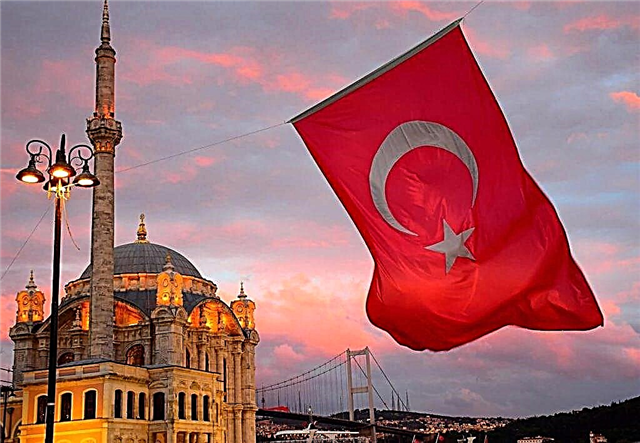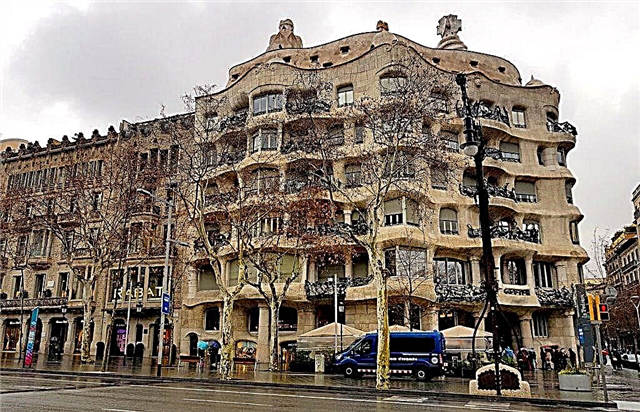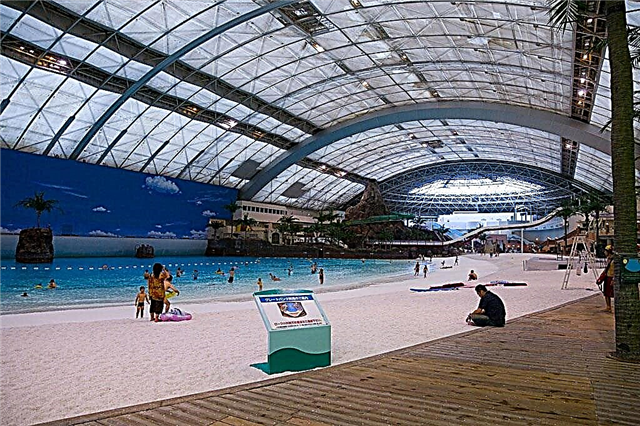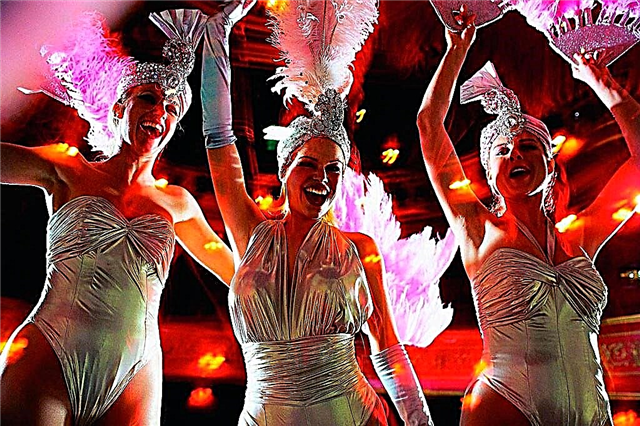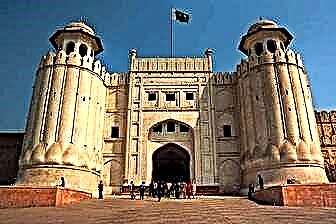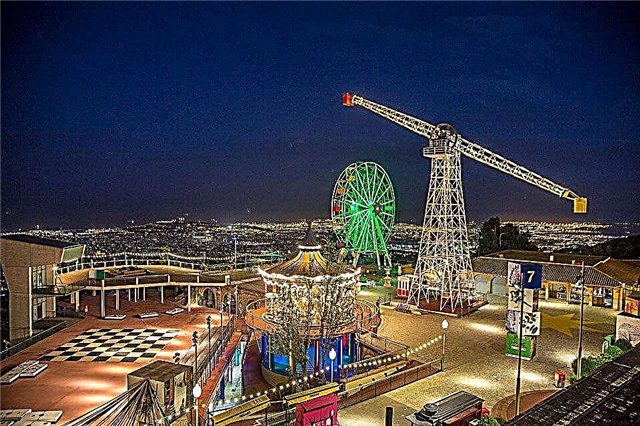During the summer holidays, parents often think: what activities are there for children in Barcelona. At first glance, the resort is aimed at adult tourists. But in fact, in the capital of Catalonia, children of different ages will find classes according to their interests. At the same time, schoolchildren will be able to engage in additional education: information is given in an interesting form on a variety of subjects. And kids will spend time not only on the playgrounds: special quests have been developed for them. Children will learn something new in the process of an exciting game. In the meantime, young scientists are immersed in their studies, parents are invited to relax in the shade.
Cable car

If the child has no fear of heights, he will enjoy the cable car ride. The cable car opened after reconstruction in 2007, and was built in 1970. Now it is a modern lift with 55 powerful cabins. Each can accommodate up to 8 adults.
In 8 minutes of ascent, tourists climb 85 m, overcoming a path of more than 750 m.But it is not at all necessary to go to the end, you can get off at one of 3 stations:
- Parc Montjuic invites you to get acquainted with the facilities built for the 1992 Olympics. Children love the Olympic rings, the Olympic and Sports museums. If they are lucky, the guys will attend sports competitions at the Sant Jordi Palace. At the same station, the Spanish Village and the Museum of Catalonia are located (the expositions will definitely appeal to young intellectuals).
- In Mirador, botanists will explore the succulent garden, while creative people will admire the views of the sea and the capital of Catalonia. Future sailors and travelers will be interested in the panorama of the port.
- Young historians will want to visit the last station of the cable car (Castell): here is the ancient fortress of Montjuïc, built in the 17th century. Today, you can not only inspect the building: cultural events are held on the territory of the castle. And at the restaurant, young linguists will have a delicious lunch and hone their knowledge of foreign languages: a friendly atmosphere reigns here.
It is important to remember: the cable car is not part of the city's integrated transport system: for an exciting journey, you need to buy a ticket.
Tibidabo amusement park

A visit to the amusement park is a must-see for children of all ages. And Tibidabo is at the top of the mountain, which adds to his charm. At first glance, there are ordinary and familiar entertainment here. But you have to get here on a blue tram. This trailer has been bringing tourists to the mountain since 1901. By the way, the route was specially designed to take tourists to the amusement park, built in 1889.
The tickets are sold by the conductor, and the wagon rides slowly, which allows you to enjoy the surrounding landscapes. In Tibidabo, guests are greeted by courteous staff dressed in national costumes. And the panorama from the Ferris wheel will not leave anyone indifferent. While the children are having fun, their parents can spend time on the shady observation deck. In Tibidabo, time flies by for everyone.
Magic Fountain of Montjuic

This building will be of interest to young historians and future engineers. The project of engineer Bouygaz, developed by him at the beginning of the 20th century, seemed impossible to implement. Everything was revolutionary:
- closed cycle of water supply
- variable jet heights
- backlight
- pool volume
- the very location of the fountain
But nevertheless, by the time of the opening of the World Exhibition in 1929, the unique hydrotechnical structure started working. It was immediately named magic: the fountain required the efforts of 20 people to function. All the guests of Catalonia went to see the unusual jets. The building existed unchanged until 1992. And for the opening of the Olympics, a large-scale reconstruction was carried out: the fountain became not only colorful and dancing, but also singing. Today, during the show, modern and classical music sounds, the jets change color and move rhythmically. And all this is controlled by automatic equipment.
Interesting! The facility is located on an area of 3000 square meters. The jets rise to a height of 16 floors. More than 4000 colors and shades are used for backlighting.
Citadel Park

It is pleasant to take a walk in the park: here children of different ages will find something to their liking. Young historians will get acquainted with the artifacts of the fortress, zoologists will observe animals at the local zoo, and geologists will study the exhibits at the Geological Museum. After the defeat of Catalonia, the Spanish king Philip 5 ordered to build a fortress in the center of the city. After 150 years, it ceased to be an important strategic site, but continued to remind the Catalans of tragic days. That is why a significant part of the building was demolished.
Today, on the territory of the former fortress, a park is laid out, the most visited objects of which are:
- Zoo. 7,500 animals live in it, including representatives of rare species. And for lovers of entertainment, shows with the participation of sea animals (dolphins and sea lions) are held every day. The territory is decorated with the fountain Lady with an umbrella.
- Fountain Cascade with a grotto. This is one of the first creations of the great architect Antoni Gaudi.
- Dragon Castle. This interesting building is decorated with sculptures of animals and plants. It houses a zoological exposition.
On the territory of the Citadel complex there is a building where the Parliament of Catalonia sits. The park is shady: there are many flower beds and trees (there is even an orange grove).
Spanish village

Young ethnographers will appreciate the project. The politician Pucci-Cadafalc proposed to create a picturesque village on the territory of Montjuic. Architects and artists were involved in the implementation. They visited villages in Spain, chose the most colorful buildings. Then, buildings and streets were built on the allocated area: some on a 1: 1 scale, some on a reduced scale. The work was appreciated by the critic Miguel Utrillo.
The result is a complex image of the life of the Spanish provinces:
- Castile
- Catalonia
- Navarra
- Basque countries
- Aragon
- Andalusia
- Balearic Islands
- Galicia
- Extremadura
For the construction, the authors tried to use original (or similar) materials. Project goal: to help guests to know Spain in 1 hour. And they built a village for the opening of the World Exhibition in 1929.
Bolshoi Theater "Liseo"

This theater will be interesting for young historians and musicians. Liceo was created with the money of honest investors, which is a rarity for such a large-scale construction. At first, it was planned to hold concerts and give those who wish a musical education. But in 1847 a new, more spacious building was built.
The theater was destroyed several times and rebuilt again:
- 1861 (fire)
- 1893 (terrorist attack)
- 30s of the twentieth century (civil war)
- 1994 (fire)
At the beginning of the twentieth century, Liceo hosted the troupe of Sergei Diaghilev (the famous Russian seasons). After the last reconstruction, the theater became the second largest European theater.
Park Guell

Teenagers will appreciate Park Güell: even after 100 years, it looks like a challenge to boring everyday life. And the ensemble was created in an unusual way:
- The patron Eusebi Guell decided to create a garden city on the outskirts of Barcelona (an idea quite common for the early 20th century). But the author of the project faced unexpected difficulties: the price of the plots turned out to be high for those Catalans who wanted to live on the outskirts. Those who could pay were not happy with the place: they preferred the city center.
- The project seemed to have collapsed. But one of the plots was acquired by the talented architect Antoni Gaudi. The infrastructure and unusual design of the territory made the plots a desirable acquisition (Gaudi himself lived in Park Guell for more than 20 years).
Gaudi was the progenitor of architectural solutions based on ... garbage. For his compositions, he demanded that workers bring him broken dishes, shards from bottles - everything that people throw away and forget about. The famous bench that encircles the hillside is inlaid with shards of crockery. And the ceiling of the hall with amazing acoustics is lined with glasses from bottles for rose water. Guests entering the park are greeted by gingerbread houses, the roofs of which seem to be covered with glaze.
Gaudí also acted as a landscape designer: he developed a system of walkways and paths in the park. Today, it is pleasant to relax in the park or enjoy cultural events: concerts are regularly held in the hall, and the Gaudí Museum has an interesting permanent exhibition. There is a playground for smaller children. And you can satisfy your hunger in a restaurant located in the park.
Orth's Labyrinth

Film fans will be happy to walk in the Horta Labyrinth: after all, it was here that part of the film Perfumer was filmed. And the rest of the children will have a pleasant time in the oldest park in Catalonia.
Orth's maze was not created immediately:
- The park was designed in the 18th century as the private garden of the Marquis Desvalls. Then the romantic part of the park was laid.
- Then, in the 19th century, the adjacent territories were annexed to the palace, the park expanded and became accessible to the townspeople.
- In the 20th century, the private garden was transferred to the city, and a large-scale reconstruction was required. After it was held, access to the Horta Labyrinth became free, but then it was limited due to the damage caused to the park equipment.
The labyrinth itself consists of cypress trees in a certain order, it is located in the neoclassical part of the garden. It is not easy to get out of it: therefore, the walking people get to know each other, looking for a way out. And after successfully completing the challenge, it's a good idea to take a stroll through the romantic part of the garden. In the Horta Labyrinth, rare species of herbs, flowers and trees are planted, therefore, to minimize human intrusion into nature, a limited number of tourists are allowed here: until the first groups finish their inspection of the garden, the next are not allowed to come here.
Oceanarium

This is the ideal place for a young zoologist or chemist to relax. The rich exposition of the Oceanarium will acquaint children with the inhabitants of the depths of the Mediterranean, tell about their habits and lifestyle, describe the properties of water at different depths.
You can observe the inhabitants of the sea both while standing in the hall and while in the tunnel. Conventionally, the Oceanarium consists of 2 parts:
- Systems of aquariums and a tunnel 80 m long. Here visitors watch the marine life for hours.
- A department that tells about the properties of the Mediterranean water and their impact on the inhabitants of the depths. Penguins are also represented here. Moreover, this is the best collection of these mammals in Europe.
Kids will have a great time in the playground: there are children's and sports grounds here. While the children are having fun, parents can relax on the benches placed in the Oceanarium.
Casa Batlló

This project was the start of the independent work of the great Antoni Gaudi: from that moment on, the architect relied only on an independent vision, departing from the accepted canons. Therefore, visiting the site will be beneficial for future architects and designers. And the rest of the guys will just admire the unusual building. The manufacturer Batlló, who invited Gaudí to develop the project, intended to destroy the building of 1875 and build a house on the vacant place.
But the architect made an independent decision:
- Taking the previous building as a basis, Gaudi added 2 facades to it. Now the main facade turned out to be facing the avenue, and the back one - into the courtyard.
- The architect completely redesigned the lower floor, creating a basement and an attic. The roof has now become stepped.
- Gaudí created an inner courtyard of light: this improved the lighting and ventilation of the building. As a result of all the activities, the house has become not only original, but also ergonomic.
The reconstruction turned an ordinary building into an unusual one: there are practically no straight lines in it. There is still controversy about the symbolism that Gaudi put into his creation. Maybe it is the young architect who will later answer all the remaining questions.
Blau Museum of Natural Sciences

This is an amazing place for young naturalists to spend time to their advantage. Here, interactive simulators and screens tell about the history and life of our planet. There are several sections:
- The Living Planet tells about the origin of the Earth and the Solar System. Here in the twilight the starry sky flickers.
- In the Biography of the Earth, a young researcher can simulate situations that he is unlikely to see in wildlife.
- In the Earth today, the child will get acquainted with the creatures that live on the planet; learns about how diverse (and at the same time vulnerable) life.
But that's not all. Children will receive answers to additional (sometimes the most unexpected) questions in the Islets of Science. And for kids there are scientific methods of cognition: the kids will receive answers to questions (of course, in a playful way) in the Scientific nest.
By the way! The Blaeu Museum (like the Botanical Gardens and the Citadel Park on Montjuïc) is part of the large Museum of Natural Sciences.
Kosmokaysha Museum

In its current version, the center began operating in 2004: it was previously part of the Science Museum of Barcelona. And the expositions will be interesting for children who are fond of natural sciences. Moreover, age does not matter: even a kid will find an interesting exhibition for himself.
Kosmokaysha has a permanent exhibition, which consists of thematic sections:
- Department dedicated to matter. It consists of subsections: dead matter, living matter, civilized matter and smart matter. Information is presented in the form of interactive stands on which seemingly ordinary things are demonstrated. Boring school experiences turn into interesting activities.
- The stages of planet formation are fascinatingly described in the Geological Wall section. The screens show the mountains in cross-section, the movement of the plates is described.
- A wildlife corner is presented in the Flooded forest section. The Amazon forest has been recreated here. You can observe both through glass and directly from inside. Young biologists have the opportunity to immerse themselves in the cradle of life on the planet.
- An interactive planetarium will show our solar system and neighboring galaxies.
- The interactive playground is designed for the youngest guests of Kosmokays. Here they will receive basic knowledge in a playful way.
For hungry guests, Kosmokaysha offers a snack at a local cafe. The prices are quite pleasant here. And the dishes are delicious. The center is funded by private investors (La Caixa company), so there is no need to buy tickets for children.
Chocolate Museum

An excursion to the chocolate center is a gift for young sweet tooths. This exposition was opened in 2000 at the initiative of the inhabitants of Catalonia: after all, their ability to prepare chocolate products is known all over the world. In addition, chocolate came to Europe thanks to the conquistadors. They brought cocoa beans and the first recipes to the continent.
The first chocolate was bitter: it was made without sugar, with the addition of bitter pepper. But the queen liked it, and soon coffee shops opened in the capital of Spain, offering to taste the queen's favorite drink. Soon the recipe was changed: sugar, vanilla, cinnamon were added instead of pepper. And after a while, the chocolate became hard: they began to pour tiles from the powder, and then cook the figurines. Today, the chocolate center not only displays the products of famous chocolatiers, but also gives a master class.
The participants are offered plastic mass, from which (under the guidance of the master) the author's figurine is prepared. You can take it with you. And the delicious excursion should be completed in a cafe, where you will continue your acquaintance with the traditions of making chocolate in Spain.
Zoo

One of the most interesting zoos in Europe will be interesting for children of all ages. It is located in the Citadel Park. The animal collection consists of over 300 animal species and 400 plant species. The administration of the center is guided by the principle of comfortable keeping animals: each instance occupies a spacious aviary or pool. Nearby there are tablets with a brief description of the species and its habitat. The employees of the complex participate in national programs to help rare animals.
One of the projects is the restoration of the otter population. The zoo conducts scientific work, wins grants, which allow not only to comfortably keep existing animals, but also to acquire new ones. On the territory you can have a snack, and if you wish, arrange a picnic; there is a playground for the kids. Several shops offer souvenirs. And it is proposed to move not only on foot, but also by train or electric car.
Maritime museum

The exposition will be interesting for young sailors and travelers. At the old Shipyards, ships were built and repaired, starting from the 13th century. Few exhibitions boast seven centuries of history. The shipyard developed simultaneously with shipbuilding: in the 18th century it was necessary to widen the passage to create a large ship. Until the middle of the 18th century, docks were used for the repair or construction of ships. Then it was used as a city arsenal.
And in 1936 the army transferred the shipyard to the city. The opening of the first exposition took place in 1941. And in 1976 the shipyard building was recognized as an architectural monument, and in 2006 the center turned into a national museum. Boys and girls will be interested to look at the place where ships were created in the century of discoveries, warships were built. Some of the caravels are on display in dry dock. You can even climb them.
Camp Nou stadium

Young fans will have a great time at the five-star stadium. It was built over half a century ago to provide the legendary Barcelona (Barça) with a new training ground. Camp Nou still perfectly suits its purpose: but a decision has already been made to reconstruct it. The stadium will be able to accommodate up to 112,000 people, a sliding roof will appear. There is a museum at Camp Nou. The permanent exhibition offers documents, photographs of club members, personal belongings of football players.
Fans can trace the history of Barça from its inception to its last days. Part of the exhibition is dedicated to the work of Spanish artists. The atmosphere in the center is amazingly friendly: they believe that Barça is more than a regular football club. And in terms of attendance, this place is second only to the exposition of Salvador Dali.
Port Aventura

Children of any age will have a great time here. In PortAventura there is not only a water park with all water activities. On the territory of the complex, it is proposed to visit several corners of the world at once:
- Mediterranean. In this part of the center, visitors not only have fun, but also get to know the Catalan culture, of which the cuisine is a part.
- Wild West. This department echoes the setting of the Western American states. Visitors will shoot at the shooting range, see the rodeo, ride the train.
- Mexico. Young historians will have a great rest and study the Mayan culture.
- China. All attractions are the embodiment of ancient culture: this is a tea ceremony and a flying dragon.
- Polynesia. Spectators will descend into the mouth of the volcano, see and hear drums.
- Sesame. This is a place for dreamers: fairy tales from all over the world come to life here.
You won't be bored in PortAventura: the center presents more than 100 programs every day.
Shop-Museum of Magic

It will be interesting for any child: after all, childhood itself consists of dreams and illusions. At first (in 1881) it was an ordinary shop where magicians and sorcerers bought the necessary accessories. Subsequently, the owner decided to supplement the sale with an exposition. And today the center offers:
- see the tools of magicians and sorcerers of past centuries
- see (and participate) in an unusual show led by the host guide
- learn simple tricks
- buy something as a keepsake
In this center, not only children, but also their parents will willingly relax.
Rope park Barcelona Bosc Urba

It is difficult for active children to inspect expositions, but they will not refuse to spend time in the real jungle. Routes are laid above the ground at different levels. Plank paths, rope rails, reliable belay and a roof over your head - everything for active recreation in any weather.
The routes have varying degrees of difficulty:
- The orange track is for the little ones. The paths hang 1.5 m above the ground, and 14 obstacles are proposed to pass.
- The height of the Blue Route is 4 m. The obstacles are already 19. And children from 8 years old are allowed here.
- The red track consists of 20 obstacles and is located at a height of 6 m. Children over 12 years old are participating.
Every child receives reliable insurance, so injuries are excluded. You have to fight with your own fear and weakness.
Children's gallery PLOM
Creative kids will love this unusual place. And it doesn't matter at all whether they can draw. Contemplation of the works of famous artists, participation in master classes develops abstract thinking and promotes relaxation. Children create works both individually and collectively. And as tools, paints, pieces of fabric, colored paper are used - everything that is required to create a masterpiece. Time flies by in the gallery.

